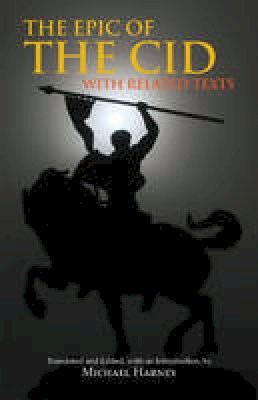19%OFF

Stock image for illustration purposes only - book cover, edition or condition may vary.
The Epic of The Cid: with Related Texts
Unknown
€ 20.99
€ 16.99
FREE Delivery in Ireland
Description for The Epic of The Cid: with Related Texts
Paperback. A powerful warrior in the Christian reconquest of medieval Spain, a formidable strategist, and a charismatic leader, Rodrigo Diaz de Vivar, the 'Cid' deeply impressed his contemporaries, both Christian and Muslim. This title records the deeds of the 'Cid' of history and legend. Num Pages: 256 pages. BIC Classification: 1DSE; HBJD. Category: (G) General (US: Trade). Dimension: 216 x 143 x 14. Weight in Grams: 308.
The Epic of the Cid records the deeds of Rodrigo Diaz de Vivar, the Cid of history and legend. A powerful warrior in the Christian reconquest of medieval Spain, a formidable strategist, and a charismatic leader, the Cid deeply impressed his contemporaries, both Christian and Muslim. Already, in his lifetime, songs, stories, and chronicles were devoted to his exploits. In offering both a highly readable, colloquial prose translation of El Cantar de Mio Cid and selections from a wide variety of those contemporary accounts, this volume brings the historical figure back to life for modern readers. Harney's substantial Introduction and annotation provide the historical, military, and literary background necessary for an informed reading of the texts; also included are maps, a compendium of proper names, a bibliography, and an index.
Product Details
Publisher
Hackett Publishing Co, Inc United States
Number of pages
249
Format
Paperback
Publication date
2011
Condition
New
Weight
309g
Number of Pages
256
Place of Publication
Cambridge, MA, United States
ISBN
9781603843157
SKU
V9781603843157
Shipping Time
Usually ships in 5 to 9 working days
Ref
99-2
About Unknown
Michael Harney is Associate Professor of Spanish and Portuguese, University of Texas at Austin.
Reviews for The Epic of The Cid: with Related Texts
Harney's translation and literary panorama will become a standard reference for students and scholars throughout the English-speaking world for decades to come. Harney's profound knowledge of the cultural and creative ferment that surrounded the birth of this masterpiece is unchallenged. . . . The complementary medieval texts that Harney assembles
all the bright fragments that make up this mosaic of a ferocious warrior, clan chieftain, family man, and hero
have never before been brought together in one place with reliable translations from the Arabic, Latin, and Spanish.
George Greenia, College of William & Mary Many a student of medieval history or romance literature have had the pleasure of reading El Cid , but few have been given the opportunity to engage other sources which complement and, at times, contradict the story found in this epic. Michael Harney, an expert in medieval and Renaissance Spanish literature, seeks to rectify such an imbalance with a volume comprising an excellent prose translation of not only the lay of El Cid but also excerpts taken from seven additional texts redacted from as early as the late eleventh century to as late as the early sixteenth century. Harney has succeeded in crafting remarkably engaging and accessible prose translations of the aforementioned romance works
more so than any other translations which this reviewer has encountered to date. Thanks to Harney's gift for translation, this volume will also allow the reader to better understand how the included stories could have riveted their premodern audiences.
Comitatus A great translation. Harney's prose translation would be a great source for undergraduate courses, especially those on the Middle Ages or Spain. The positive features of Harney's translation are clear, precise translations of key terms and words, making it easier to follow the verse translations; a glossary of key terms; and a set of related texts to the El Cid Epic . Harney's introduction in addition to these related texts provides students with a fuller view of the historical Cid, not the one-dimensional character of the Epic. Harney also does a good job of framing the context of the Cid story. Highly recommended for undergraduate courses.
John Hunt, Department of History, Utah Valley University
all the bright fragments that make up this mosaic of a ferocious warrior, clan chieftain, family man, and hero
have never before been brought together in one place with reliable translations from the Arabic, Latin, and Spanish.
George Greenia, College of William & Mary Many a student of medieval history or romance literature have had the pleasure of reading El Cid , but few have been given the opportunity to engage other sources which complement and, at times, contradict the story found in this epic. Michael Harney, an expert in medieval and Renaissance Spanish literature, seeks to rectify such an imbalance with a volume comprising an excellent prose translation of not only the lay of El Cid but also excerpts taken from seven additional texts redacted from as early as the late eleventh century to as late as the early sixteenth century. Harney has succeeded in crafting remarkably engaging and accessible prose translations of the aforementioned romance works
more so than any other translations which this reviewer has encountered to date. Thanks to Harney's gift for translation, this volume will also allow the reader to better understand how the included stories could have riveted their premodern audiences.
Comitatus A great translation. Harney's prose translation would be a great source for undergraduate courses, especially those on the Middle Ages or Spain. The positive features of Harney's translation are clear, precise translations of key terms and words, making it easier to follow the verse translations; a glossary of key terms; and a set of related texts to the El Cid Epic . Harney's introduction in addition to these related texts provides students with a fuller view of the historical Cid, not the one-dimensional character of the Epic. Harney also does a good job of framing the context of the Cid story. Highly recommended for undergraduate courses.
John Hunt, Department of History, Utah Valley University
